

Salamander - Freshwater Monster - ALPF Medical Research. Lizardlike animal of Europe that is immune to fire; see SEMIMYTHICAL BEASTS.
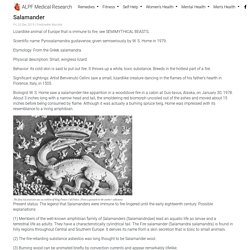
Scientific name: Pyrosalamandra gustavense, given semiseriously by W. S. Home in 1979. Etymology: From the Greek salamandra. Physical description: Small, wingless lizard. Behavior: Its cold skin is said to put out fire. Significant sightings: Artist Benvenuto Cellini saw a small, lizardlike creature dancing in the flames of his father's hearth in Florence, Italy, in 1505. Biologist W. Present status: The legend that Salamanders were immune to fire lingered until the early eighteenth century. . (1) Members of the well-known amphibian family of Salamanders (Salamandridae) lead an aquatic life as larvae and a terrestrial life as adults. Tetrapod Zoology : Aquatic proto-people and the theory hypothesis of initial bipedalism. Regular readers will know that I am an unashamed fan of non-standard theories, aka fringe theories or whacky theories, and of course we looked just recently at the haematotherm theory.
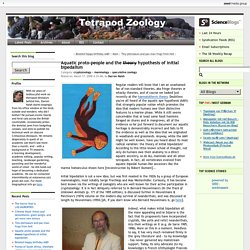
Doubtless you've all heard of the aquatic ape hypothesis (AAH): that strangely popular notion which promotes the idea that modern humans owe their distinctive features to a marine phase. While it still seems conceivable that at least some fossil hominins foraged on shores and in mangroves, all of the evidence so far put forward to document our aquatic heritage is demonstrably incorrect and fails to fit the evidence as well as the idea that we originated in woodlands and grasslands. Anyway, while the AAH might be well known, have you heard about its most radical variation: the theory of initial bipedalism? According to this little known school of thought, not only do humans owe their anatomy to a direct aquatic ancestry, so do ALL mammals and all other tetrapods. SKY CREATURES By TREVOR JAMES CONSTABLE (OCR) PDF please download upload and share : Free Download, Borrow, and Streaming. Rods-Protopterygote.
Invasion by Washing Water. Home Donald R.
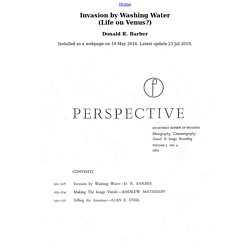
Barber Installed as a webpage on 19 May 2016. Latest update 23 Jul 2019. Comments welcome. What caused strange blobs to rain down on the small town of Oakville for weeks? : UnresolvedMysteries. A flying what? Symbiosis retracts paper claiming new species arise from accidental mating. In 2009, Donald Williamson made what many biologists said was an extraordinary claim: The reason caterpillars become butterflies is that two different species accidentally mated with one another.
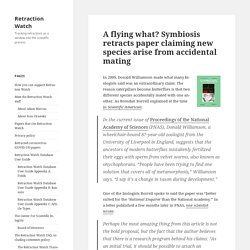
As Brendan Borrell explained at the time in Scientific American: In the current issue of Proceedings of the National Academy of Sciences (PNAS), Donald Williamson, a wheelchair-bound 87-year-old zoologist from the University of Liverpool in England, suggests that the ancestors of modern butterflies mistakenly fertilized their eggs with sperm from velvet worms, also known as onychophorans. “People have been trying to find one solution that covers all of metamorphosis,” Williamson says. “I say it’s a change in taxon during development.” One of the biologists Borrell spoke to said the paper was “better suited for the ‘National Enquirer than the National Academy.'” Now, a journal has retracted a related paper, in Symbiosis, “Larval genome transfer: hybridogenesis in animal phylogeny: Dr.
Why everybody laughs at Williamson, Lynn Margulis’ “best friend” By Piter Kehoma Boll Leia em português What would you think if someone came to you and said that your pet snail accidentally got pregnant and you’re the father?
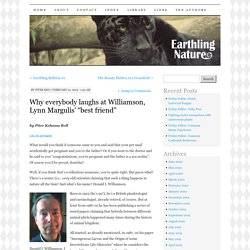
Or if you went to the doctor and he said to you “congratulations, you’re pregnant and the father is a sea urchin”. Of course you’d be proud, dontcha? Well, if you think that’s a ridiculous nonsense, you’re quite right. Born in 1922 (he’s 90!) All started, as already mentioned, in 1987, on his paper “Incongruous Larvae and the Origin of some Invertebrate Life-Histories” where he considers the huge differences between adults and larvae in many animals, at first mainly concerning echinoderms. New Scientist. The 10 Types Of Cryptids. History of Geology: Cryptozoology and a geologist's nightmare - Vermes lapidum. "Stone Worms - Vermes lapidum, are tiny worms, which grow in sculptured rocks, especially in old buildings and walls they are found.
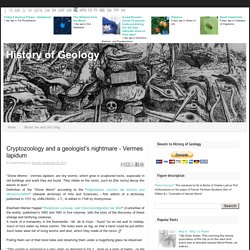
They nibble on the rocks, such as [the rocks] decay like leaves to dust. " A monk of a monastery in the Normandie - Mr. de la Voye - found "on an old wall to midday, much of rock eaten by these vermin. The holes were as big, as that a hand could be put within. Such holes were full of living worms and dust, which they made of the rocks..[]" Pulling them out of their bore holes and observing them under a magnifying glass he observed: "This vermin is enclosed in a grey shell, as depicted in Fig.1., large as a grain of barley...on the tip there is a hole, trough which the excrements can be excreted/ on the other end there is a larger hole, trough which the head can be protruded. They are entirely black, the body shows various segments, near the head there are three legs, each has two joints, not dissimilar to these of a flea. Fig.1. Fig.2. Fig.1.